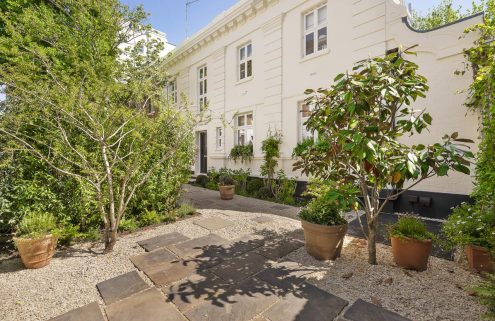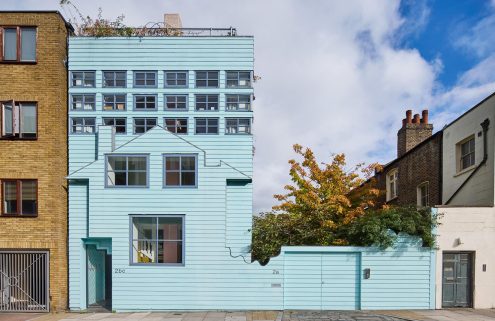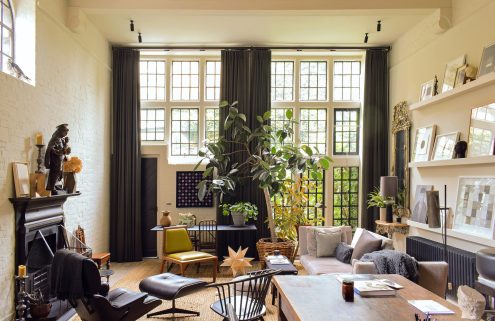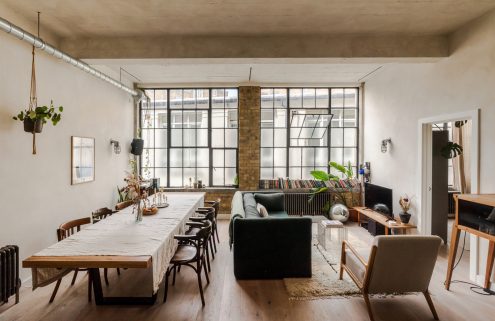All across London, hidden behind brick facades, are the writing dens of famous writers, past and present.
From Samuel Pepys and Charles Dickens to Zadie Smith and Caleb Femi, the capital has, for generations, been home to many famous literary names and provided them with endless inspiration for their works.
Right now, London has not one but two former writers’ homes up for sale – Indian poet Rabindranath Tagore’s former digs in Hampstead and the long-time Twickenham pad of the English poet Walter de la Mare. Both have bucolic surroundings and feature blue plaques.
Take a look inside these storied houses.

Walter de la Mare’s South End House in Twickenham
7 bedrooms; £10.5m via Savills / Knight Frank
In 1940, poet Walter de la Mare rented the upper floor of South End House from the Sedgwick family until his death in 1956. During the Second World War, de la Mare – who is best remembered for his poem, The Listeners – was reprimanded for failing to observe the blackout. On one occasion, the police even rowed across the Thames to complain about the brightness of his upper windows.
South End House is a grand, Grade II* listed Georgian home, built in 1721 by Captain John Gray, at the end of Montpelier Row, one of outer London’s finest Georgian streets. It has symmetrical windows, a gothic sitting room, panelled rooms and views of Marble Hill Park, with glimpses of the Thames beyond. During de la Mare’s final and mostly bedridden two years, he positioned a mirror opposite his bed so he could still enjoy the park vistas.
Credit: Savills

Walter de la Mare’s South End House in Twickenham
7 bedrooms; £10.5m via Savills / Knight Frank
In 1940, poet Walter de la Mare rented the upper floor of South End House from the Sedgwick family until his death in 1956. During the Second World War, de la Mare – who is best remembered for his poem, The Listeners – was reprimanded for failing to observe the blackout. On one occasion, the police even rowed across the Thames to complain about the brightness of his upper windows.
South End House is a grand, Grade II* listed Georgian home, built in 1721 by Captain John Gray, at the end of Montpelier Row, one of outer London’s finest Georgian streets. It has symmetrical windows, a gothic sitting room, panelled rooms and views of Marble Hill Park, with glimpses of the Thames beyond. During de la Mare’s final and mostly bedridden two years, he positioned a mirror opposite his bed so he could still enjoy the park vistas.
Credit: Savills

Walter de la Mare’s South End House in Twickenham
7 bedrooms; £10.5m via Savills / Knight Frank
In 1940, poet Walter de la Mare rented the upper floor of South End House from the Sedgwick family until his death in 1956. During the Second World War, de la Mare – who is best remembered for his poem, The Listeners – was reprimanded for failing to observe the blackout. On one occasion, the police even rowed across the Thames to complain about the brightness of his upper windows.
South End House is a grand, Grade II* listed Georgian home, built in 1721 by Captain John Gray, at the end of Montpelier Row, one of outer London’s finest Georgian streets. It has symmetrical windows, a gothic sitting room, panelled rooms and views of Marble Hill Park, with glimpses of the Thames beyond. During de la Mare’s final and mostly bedridden two years, he positioned a mirror opposite his bed so he could still enjoy the park vistas.
Credit: Savills

Rabindranath Tagore’s pre-war Hampstead home
3 bedrooms; £2,699,500 via Goldschmidt & Howland
This Victorian-era Hampstead home is where Rabindranath Tagore lived when he came to London in 1912. It is thought that the Bengali literary giant translated his famous Gitanjali poems into English here, for which he received the Nobel Prize in Literature a year later.
The renovated 1860s villa – which nestles in the secluded Vale of Health enclave in Hampstead Heath park – has a gothic-style roof gable, an arched front door and large windows which flood its three reception rooms with light. There is a roof terrace, too, that peeks out over the chimney tops towards the woodland.
Credit: Goldschmidt & Howland

Rabindranath Tagore’s pre-war Hampstead home
3 bedrooms; £2,699,500 via Goldschmidt & Howland
This Victorian-era Hampstead home is where Rabindranath Tagore lived when he came to London in 1912. It is thought that the Bengali literary giant translated his famous Gitanjali poems into English here, for which he received the Nobel Prize in Literature a year later.
The renovated 1860s villa – which nestles in the secluded Vale of Health enclave in Hampstead Heath park – has a gothic-style roof gable, an arched front door and large windows which flood its three reception rooms with light. There is a roof terrace, too, that peeks out over the chimney tops towards the woodland.
Credit: Goldschmidt & Howland

Rabindranath Tagore’s pre-war Hampstead home
3 bedrooms; £2,699,500 via Goldschmidt & Howland
This Victorian-era Hampstead home is where Rabindranath Tagore lived when he came to London in 1912. It is thought that the Bengali literary giant translated his famous Gitanjali poems into English here, for which he received the Nobel Prize in Literature a year later.
The renovated 1860s villa – which nestles in the secluded Vale of Health enclave in Hampstead Heath park – has a gothic-style roof gable, an arched front door and large windows which flood its three reception rooms with light. There is a roof terrace, too, that peeks out over the chimney tops towards the woodland.
Credit: Goldschmidt & Howland

Rabindranath Tagore’s pre-war Hampstead home
3 bedrooms; £2,699,500 via Goldschmidt & Howland
This Victorian-era Hampstead home is where Rabindranath Tagore lived when he came to London in 1912. It is thought that the Bengali literary giant translated his famous Gitanjali poems into English here, for which he received the Nobel Prize in Literature a year later.
The renovated 1860s villa – which nestles in the secluded Vale of Health enclave in Hampstead Heath park – has a gothic-style roof gable, an arched front door and large windows which flood its three reception rooms with light. There is a roof terrace, too, that peeks out over the chimney tops towards the woodland.
Credit: Goldschmidt & Howland























